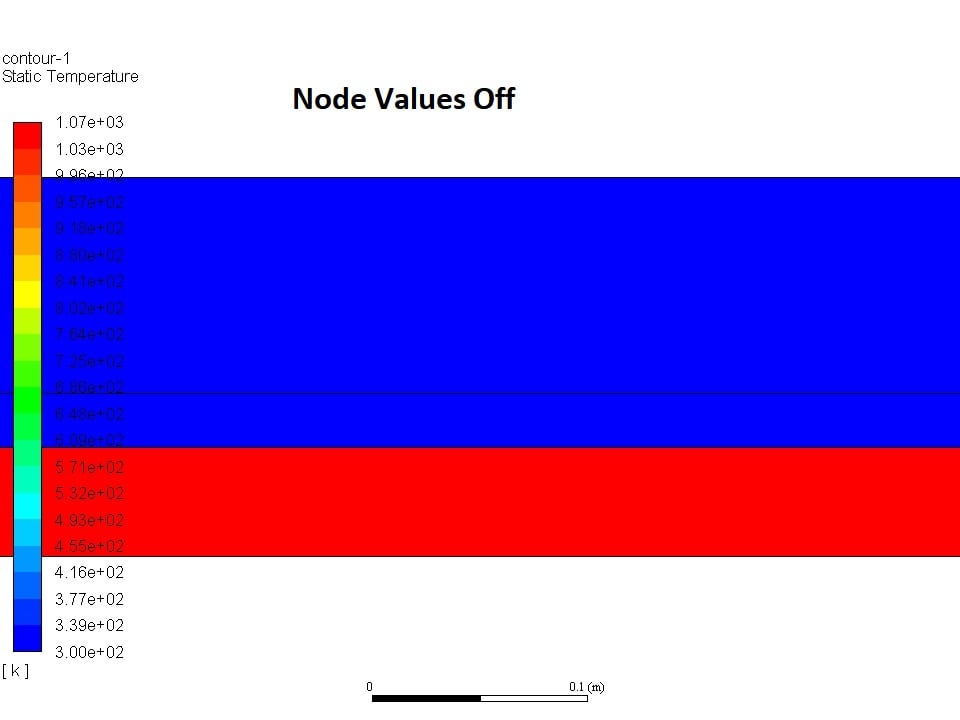-
-
August 11, 2020 at 5:34 am
hardik2309
SubscriberHello,
I am solving transient heat transfer problem (in Fluent) between two solids using S2S radiation model.
Solid 1 is at fixed temperature of 1073 K. The initial temperature of Solid 2 is 300 K. (Fig 1)
There is fluid body between two solids. Currently, I am comparing these results with Ansys thermal and hence I have used a fluid with very low thermal conductivity (1e-8) and low specific Heat (1e-5) so that is practically does not affect heat transfer.
In this case, since the solid-1 is at high temp, radiative heat transfer should take place and temp of solid 2 should gradually increase.
The problem is, no matter what the time step size is, the "Area weighted average temp" of solid 2 (surface) jumps to 590K just after first time step (Shown in image). This is unrealistic. The same setup in ANSYS Thermal shows gradual temp rise.
What can cause such sudden temperature increase? I would appreciate your assistance.
Some other details of the problem
Solver : 2-D transient Fluent solver with S2S Radtiation model
Properties of solid 2: Density : 1100 kg/m3, Cp : 1300 J/kg-K, Thermal Cond : 0.58 W/m-K
Mesh : 2-D quad mesh mesh with size ~ 5mm
Time step : 0.1 s
August 12, 2020 at 3:58 pmRob
Forum ModeratorHow did you initialise the system?
August 13, 2020 at 4:33 amhardik2309
SubscriberI initialized from all zones and then patched 300 K on Solid-2 and Fluid Body.
August 13, 2020 at 10:12 amRob
Forum ModeratorPlease plot images of the temperature field at t=0 and t=next time step. Has the step converged?
August 13, 2020 at 11:52 amAugust 13, 2020 at 12:24 pmRob
Forum ModeratorRe-plot with node values off: is it the fluid or solid that's got hot? If you work out the radiation load is that sensible? Remember that heat will travel VERY quickly as thermal radiation.
August 13, 2020 at 2:43 pmhardik2309
Subscriber
Here are two plots : one with Nodes values on and other with node values off.
They show different values. High temperature at the solid-fluid interface is very high when using node values.
What causes this difference?
The radiation flux has realistic values. (matching with analytical values)
Yes, radiation travels very quickly. But, solids cannot get hot with such unrealistic rate.
As I am writing report file of average temperature at the interface and it uses node values it shows the jump. Is there any way to use cell values in report?


August 14, 2020 at 8:29 amRob
Forum ModeratorNot sure, change the range to see if the issue is graphics or there is a temperature rise at that location.
August 14, 2020 at 9:00 amhardik2309
SubscriberIt shows the same results even after changing the temperature range.
And those high values are reported in the report file too.
August 14, 2020 at 9:01 amRob
Forum ModeratorWith node values off? What are you reporting?
August 14, 2020 at 10:47 amhardik2309
SubscriberStatic temperature.
In the plot, I am reporting area weighted average of Static temperature.
Wall temperature gives the same result.
August 14, 2020 at 10:59 amRob
Forum ModeratorWhat happens when you run the model on? Monitor wall and volume temperatures.
August 14, 2020 at 2:42 pmhardik2309
SubscriberAs I mentioned, after sudden jump the average surface temp rises gradually. (Shown in the plot posted earlier)
Volume temperature rises gradually as it takes some time for the entire volume to get heated.
August 14, 2020 at 2:48 pmRob
Forum ModeratorSo given a surface is "thin" how long would it take to warm up if exposed to sunlight?
August 14, 2020 at 2:50 pmhardik2309
SubscriberHere is the case file.
I didnt get you point.
There in no "thin" surface. Its just interface of fluid and solid.
August 17, 2020 at 10:46 amRob
Forum ModeratorYou have a wall at that location, which is thin, and has to be there to separate the fluid & solid.
Staff aren't permitted to download or open files, so I'll leave that for someone else in the Community to have a look at your set-up.
August 18, 2020 at 11:13 amhardik2309
SubscriberYes, There is a wall -wall shadow with "0" thickness.
I hope this what you are asking.
August 25, 2020 at 1:53 pmRob
Forum ModeratorViewing 17 reply threads- The topic ‘Sudden temperature rise in transient heat transfer simulation with S2S radiation (Fluent)’ is closed to new replies.
Innovation SpaceTrending discussionsTop Contributors-
4633
-
1535
-
1386
-
1225
-
1021
Top Rated Tags© 2025 Copyright ANSYS, Inc. All rights reserved.
Ansys does not support the usage of unauthorized Ansys software. Please visit www.ansys.com to obtain an official distribution.
-


Ansys Assistant

Welcome to Ansys Assistant!
An AI-based virtual assistant for active Ansys Academic Customers. Please login using your university issued email address.
Hey there, you are quite inquisitive! You have hit your hourly question limit. Please retry after '10' minutes. For questions, please reach out to ansyslearn@ansys.com.
RETRY











